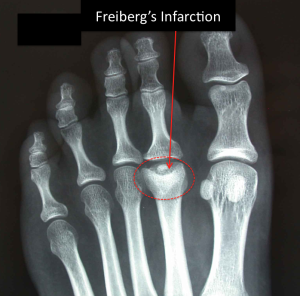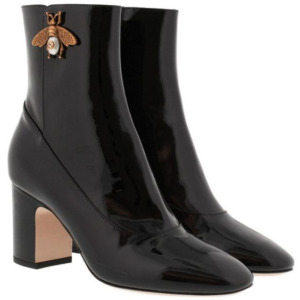
This week on Shop Talk we thought we would discuss a foot injury that we see commonly in the clinic, and which is often directly linked to the job. Or rather the uniform required for the job. What if your day involves standing on hard surfaces such as concrete for many hours, or walking up and down aisles all day? And to top it off, your uniform includes a high heel shoe?
Flight attendants and shop assistants are two professions that we get in the clinic, a lot…… Why? They are required to wear shoes that don’t necessarily suit their foot type and in some cases, particularly with fashion shop assistants, the shoes offer little support and are often poorly designed. The condition we are discussing today is often linked to this kind of use of high heel shoes and, if left untreated may lead to debilitating pain, early arthritis and surgery. Introducing Freiberg’s Infarction.

Image credit: footeducation.com
Freiberg’s Disease or infarction usually occurs in adolescents or teenagers but may also occur in later years. Initially patients will present with pain and swelling in the forefoot and careful history taking usually reveals repetitive trauma to the area either with a particular activity or shoe!
Freiberg’s Infarction is common with people that have a long 2nd metatarsal, a bunion, retracted toes or a foot type that rolls in or pronates too much. All of these things increase pressure and repetitive forces to the 2nd metatarsal head which can affect the blood supply to the area causing avascular necrosis.
This interruption of healthy blood flow to the metatarsal head may affect the shape, causing a flattening and associated microfractures to the bone. A flat metatarsal head is not conducive to flexion and essentially the articular (smooth) surface of the joint wears away causing degenerative joint disease and arthritis. Not good if you want to wear heels again!

So what do you do if you suspect something is wrong with your foot? Here are TWH’s tips for dealing with Freiberg’s Infarction –
- Get a diagnosis! Early intervention is key to a quick recovery and reduced risk of ongoing issues associated with the injury. You will need professional help with this one!
- Rest the foot for at least 4 weeks. This will require the use of a moon boot or a cast. We prefer moon boots as they can be removed to shower, sleep and drive. You do need to be strict with them though as there is a temptation to “just take it off for a bit!” You will also need to match the height of the boot on the other foot to avoid knee and back issues.
- Once out of the boot stick to lower pitched shoes for at least another 4-6 weeks. If you absolutely need to wear a heel make sure you take regular rests.
- Choose dress shoes with stability features after this to avoid reccurance. And mix your heel heights up! Everyday in high stilettos is a recipe for disaster.
- Use a dress orthotic or appropriate offloading padding in all shoes to offload the 2nd metatarsal. You will need the help of a podiatrist for this.
- Talk to your employers and make sure they are onboard with your shoe requirements. It’s fine to wear a dress shoe but stability features in work shoes are a must. Particularly if they are a heel and you are standing all day.

These Gucci boots would make a great all day work shoe providing the fit is good. The broader midi heel is fantastic for stability and comfort. A boot also supports the ankle which can aid in reducing fatigue in the feet and legs.
Good luck if you are required to wear high heels every day. It’s often not easy combining fashion and comfort, but with some understanding about your foot type the risk of foot injury can be reduced without compromising your aesthetic.
Until next time,
E&E
Image credits – Pinterest. Contact hello@the-well-heeled.com for your image to be credited


